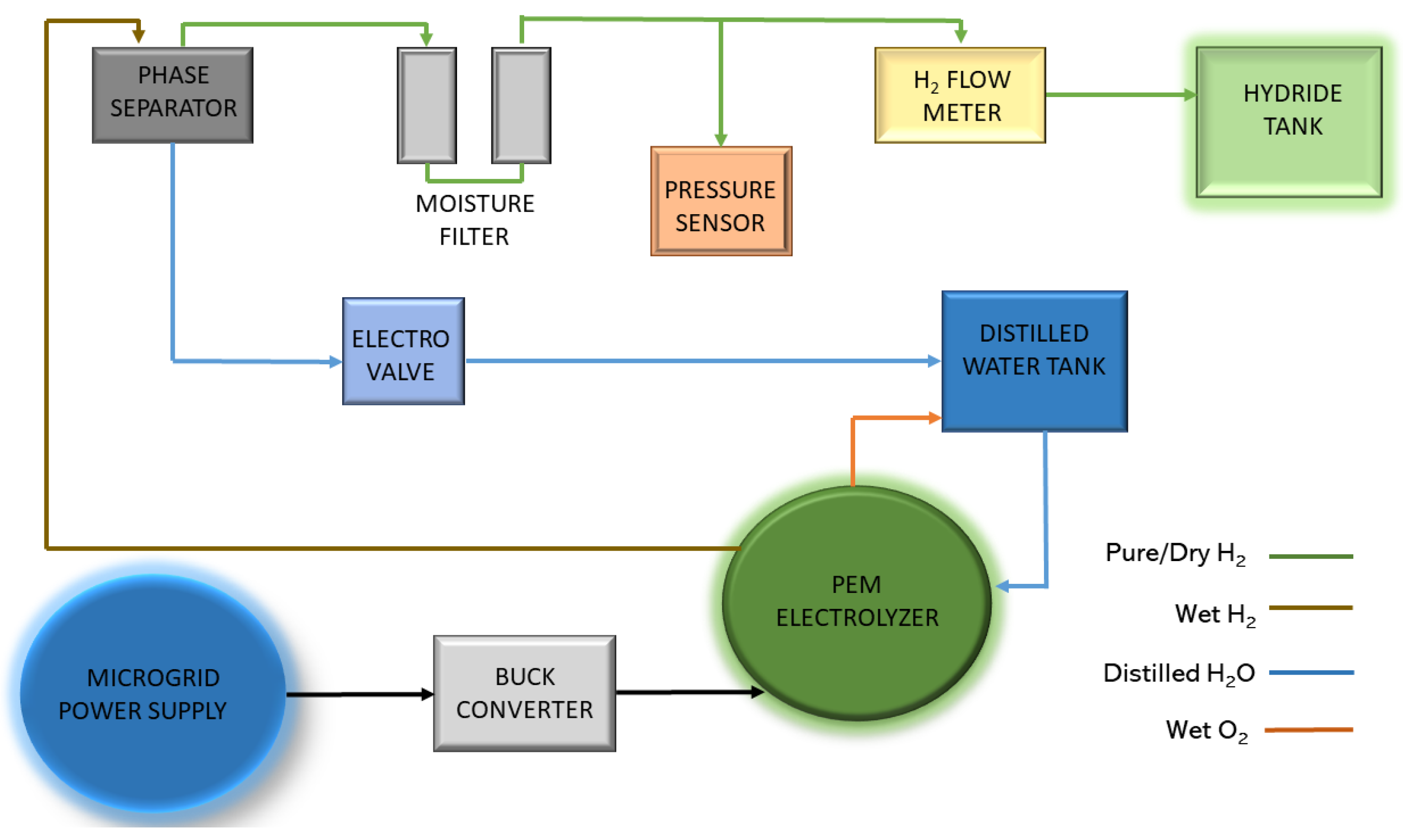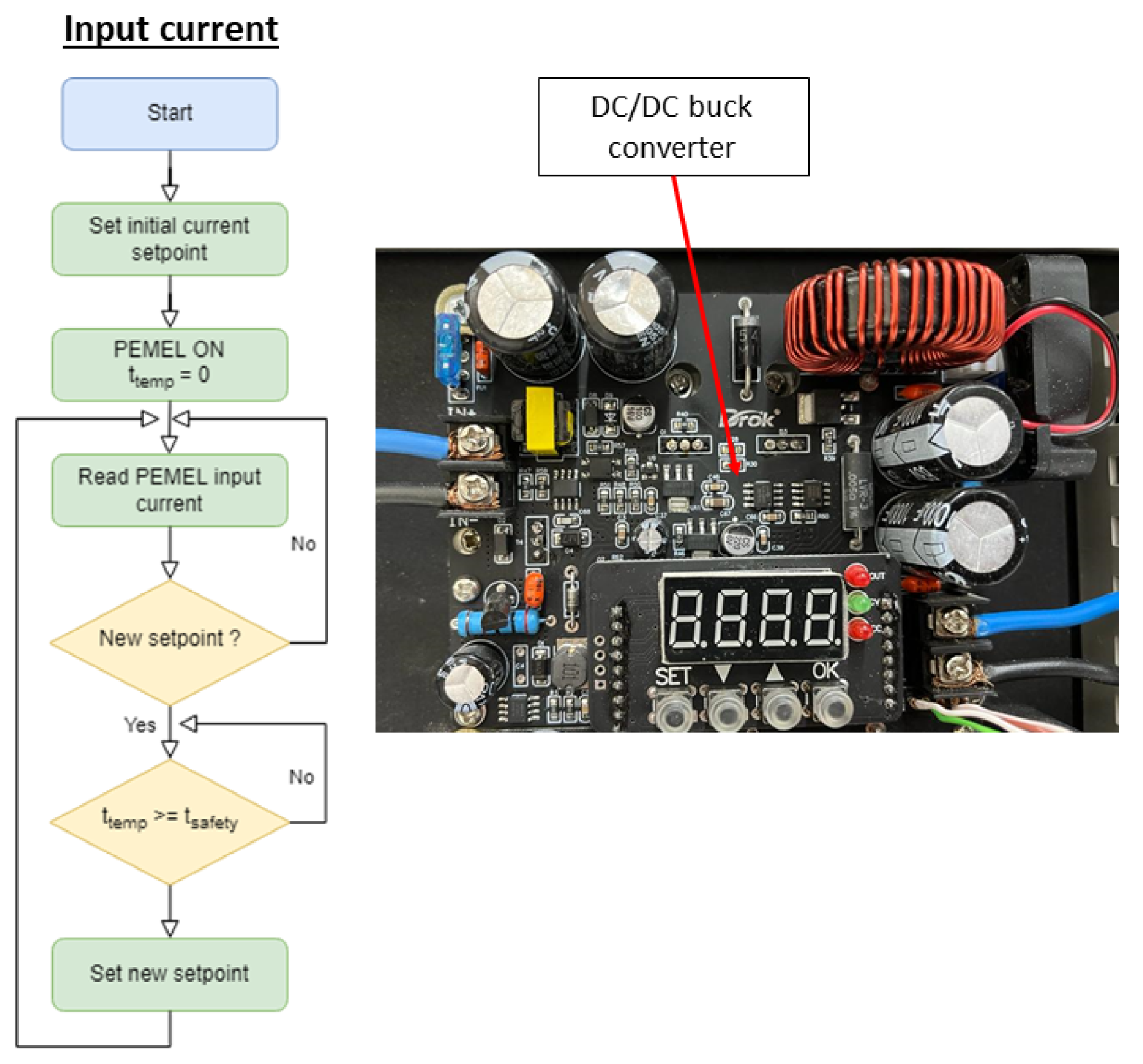Safety Measures for Hydrogen Generation Based on Sensor Signal Algorithms †
Abstract
1. Introduction
2. Materials and Methods
2.1. PEM Electrolyzer
2.2. Sensors and Actuators
2.3. Control Parameters
3. Implementation and Results
Control Algorithms
4. Conclusions
Author Contributions
Funding
Institutional Review Board Statement
Informed Consent Statement
Data Availability Statement
Conflicts of Interest
References
- González, I.; Calderón, A.J.; Andújar, J.M. Novel remote monitoring platform for RES-hydrogen based smart microgrid. Energy Convers. Manag. 2017, 148, 489–505. [Google Scholar] [CrossRef]
- Awasthi, A.; Scott, K.; Basu, S. Dynamic modeling and simulation of a proton exchange membrane electrolyzer for hydrogen production. Int. J. Hydrog. Energy 2011, 36, 14779–14786. [Google Scholar] [CrossRef]
- Folgado, F.J.; González, I.; Calderón, A.J. Simulation platform for the assessment of PEM electrolyzer models oriented to implement digital Replicas. Energy Convers. Manag. 2022, 267, 115917. [Google Scholar] [CrossRef]
- Scheepers, F.; Stähler, M.; Stähler, A.; Rauls, E.; Müller, M.; Carmo, M.; Lehnert, W. Improving the efficiency of PEM electrolyzers through membrane-specific pressure optimization. Energies 2020, 13, 612. [Google Scholar] [CrossRef]
- Feng, Q.; Yuan, X.Z.; Liu, G.; Wei, B.; Zhang, Z.; Li, H.; Wang, H. A review of proton exchange membrane water electrolysis on degradation mechanisms and mitigation strategies. J. Power Sources 2017, 366, 33–55. [Google Scholar] [CrossRef]
- Atlam, O.; Kolhe, M. Equivalent electrical model for a proton exchange membrane (PEM) electrolyser. Energy Convers. Manag. 2011, 52, 2952–2957. [Google Scholar] [CrossRef]
- Guilbert, D.; Vitale, G. Dynamic emulation of a PEM electrolyzer by time constant based exponential model. Energies 2019, 12, 750. [Google Scholar] [CrossRef]
- Weiß, A.; Siebel, A.; Bernt, M.; Shen, T.-H.; Tileli, V.; Gasteiger, H.A. Impact of Intermittent Operation on Lifetime and Performance of a PEM Water Electrolyzer. J. Electrochem. Soc. 2019, 166, F487–F497. [Google Scholar] [CrossRef]






| Control Parameters | Typology | Model/Type |
|---|---|---|
| Working temperature | Sensor | PT-100 |
| Actuator | DC fan | |
| Working pressure | Sensor | Wika A-10 |
| Input current | Sensor | Hall-effect sensor |
| Actuator | DC/DC buck converter | |
| Water supply | Sensor | Electro-optical level sensor |
| Hydrogen production | Sensor | Mass flow meter |
| Water presence/moisture | Sensor | Electro-optical level sensor |
| Actuator | Electrovalve |
Publisher’s Note: MDPI stays neutral with regard to jurisdictional claims in published maps and institutional affiliations. |
© 2022 by the authors. Licensee MDPI, Basel, Switzerland. This article is an open access article distributed under the terms and conditions of the Creative Commons Attribution (CC BY) license (https://creativecommons.org/licenses/by/4.0/).
Share and Cite
Folgado, F.J.; González, I.; Calderón, A.J. Safety Measures for Hydrogen Generation Based on Sensor Signal Algorithms. Eng. Proc. 2022, 27, 24. https://doi.org/10.3390/ecsa-9-13284
Folgado FJ, González I, Calderón AJ. Safety Measures for Hydrogen Generation Based on Sensor Signal Algorithms. Engineering Proceedings. 2022; 27(1):24. https://doi.org/10.3390/ecsa-9-13284
Chicago/Turabian StyleFolgado, Francisco Javier, Isaías González, and Antonio José Calderón. 2022. "Safety Measures for Hydrogen Generation Based on Sensor Signal Algorithms" Engineering Proceedings 27, no. 1: 24. https://doi.org/10.3390/ecsa-9-13284
APA StyleFolgado, F. J., González, I., & Calderón, A. J. (2022). Safety Measures for Hydrogen Generation Based on Sensor Signal Algorithms. Engineering Proceedings, 27(1), 24. https://doi.org/10.3390/ecsa-9-13284






